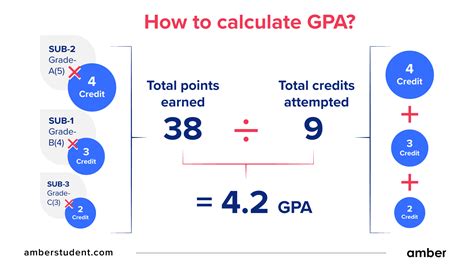GPA, or Grade Point Average, is a numerical representation of a student’s academic performance over a specific period of time, usually a semester or a year. It is calculated by dividing the total number of grade points earned by the total number of credit hours attempted.

How to Calculate GPA
To calculate your GPA, follow these steps:
- Multiply the grade points for each course by the number of credit hours for that course. For example, if you earned an A in a 3-credit hour course, you would receive 4 * 3 = 12 grade points.
- Add up the grade points for all of your courses. In our example, if you earned an A in two 3-credit hour courses and a B in a 4-credit hour course, you would have 12 + 12 + 3 * 4 = 36 grade points.
- Divide the total number of grade points by the total number of credit hours attempted. In our example, you would divide 36 by 10 (3 + 3 + 4) to get a GPA of 3.6.
Types of GPAs
There are two main types of GPAs:
- Cumulative GPA (CGPA): This is a measure of your overall academic performance throughout your entire academic career. It includes all of the courses you have taken, regardless of when or where you took them.
- Semester GPA (SGPA): This is a measure of your academic performance in a specific semester or quarter. It includes only the courses you took during that semester or quarter.
Why GPA Matters
GPA is an important factor in many aspects of your academic career, including:
- Admission to colleges and universities: Most colleges and universities use GPA as a primary factor in determining admission. A higher GPA increases your chances of being admitted to your top choice schools.
- Scholarships and financial aid: Many scholarships and financial aid programs are based on GPA. A higher GPA can make you eligible for more awards and reduce the cost of college.
- Job search: Some employers use GPA as a screening tool whenHiring for entry-level positions. A higher GPA can make you more competitive in the job market.
Common Mistakes to Avoid
When calculating your GPA, avoid these common mistakes:
- Using the wrong grade scale. Make sure you are using the correct grade scale for your school or institution.
- Including courses that you have withdrawn from. Courses that you have withdrawn from should not be included in your GPA calculation.
- Double-counting courses. If you have taken a course more than once, only the highest grade should be included in your GPA calculation.
Conclusion
GPA is an important measure of your academic performance. It can affect your admission to colleges and universities, your eligibility for scholarships and financial aid, and your job search. By understanding how to calculate your GPA and avoid common mistakes, you can ensure that your GPA accurately reflects your academic achievements.
Additional Tips
Here are a few additional tips for maintaining a high GPA:
- Attend class regularly. Attendance is essential for success in any course. Make sure you attend all of your classes and take notes.
- Study regularly. Don’t wait until the night before an exam to start studying. Study for a few hours each week to stay ahead of the material.
- Get help when you need it. If you are struggling in a course, don’t be afraid to ask your professor or classmates for help.
- Take advantage of resources. Many schools offer resources such as tutoring, writing centers, and counseling services. Take advantage of these resources to improve your academic performance.
By following these tips, you can improve your GPA and reach your academic goals.
